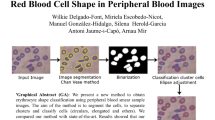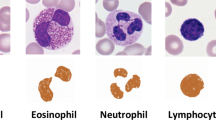Abstract
Erythrocyte shape deformations are related to different important illnesses. In this paper, we focus on one of the most important: the Sickle cell disease. This disease causes the hardening or polymerization of the hemoglobin that contains the erythrocytes. The study of this process using digital images of peripheral blood smears can offer useful results in the clinical diagnosis of these illnesses. In particular, it would be very valuable to find a rapid and reproducible automatic classification method to quantify the number of deformed cells and so gauge the severity of the illness. In this paper, we show the good results obtained in the automatic classification of erythrocytes in normal cells, sickle cells, and cells with other deformations, when we use a set of functions based on integral-geometry methods, an active contour-based segmentation method, and a k-NN classification algorithm. Blood specimens were obtained from patients with Sickle cell disease. Seventeen peripheral blood smears were obtained for the study, and 45 images of different fields were obtained. A specialist selected the cells to use, determining those cells which were normal, elongated, and with other deformations present in the images. A process of automatic classification, with cross-validation of errors with the proposed descriptors and with other two functions used in previous studies, was realized.




Similar content being viewed by others
References
Altman F (1994) Practical statistics for medical research. Chapman Hall, London
Al Zahir S, Donker H (2010) A novel regression based model for detecting anemia using color microscopic blood images. J Soft Eng Appl 3:756–761
Apostolopoulos G, Tsinopoulos S, Dermatas E (2010) Recognition and identification of red blood cell size using angular radial transform and neural networks. In: XII mediterranean conference on medical and biological engineering and computing 2010. Springer, Berlin, Heidelberg, pp 707–710
Asakura T, Hirota T, Nelson AT, Reilly MP, Ohene-Frempong K (1996) Percentage of reversibly and irreversibly sickled cells are altered by the method of blood drawing and storage conditions. J Blood Cells Mol Dis 22(3):297–306
Bacus JW (1984) Quantitative red cell morphology. Monogr Clin Cytol 9:1–27
Bacus JW, Belanger MG, Aggarwal RK, Trobaugh FG (1976) Image processing for automated erythrocytes classification. J Hystochem Cytochem 24(1):195–201
Bacus JW, Yasnoff WA, Belanger MG (1977) Computer techniques for cell analysis in hematology. In: Proceedings of the first annual symposium on computer applications in medical care (SCAMC), pp 24–35
Bergen T, Steckhan D, Wittenberg T, Zerfass T (2008) Segmentation of leukocytes and erythrocytes in blood smear images. In: Engineering in medicine and biology Society, 2008. EMBS 2008. 30th annual international conference of the IEEE, pp 3075–3078
Cover TM, Hart PE (1967) Nearest neighbor pattern classification. IEEE Trans Inf Theory 13:21–27
Das DK, Chakraborty C, Mitra B, Maiti AK, Ray AK (2013) Quantitative microscopy approach for shape-based erythrocytes characterization in anaemia. J Microsc Oxf 249:136–149
Das DK, Ghosh M, Chakraborty C, Pal M, Maity AK (2010) Invariant moment based feature analysis for abnormal erythrocyte recognition. In: Systems in medicine and biology (ICSMB), 2010 international conference on, pp 242–247
De-Lin R (1994) Topics in Integral Geometry. World Scientific, Singapore
Devijver PA, Kittler J (1982) Pattern recognition: a statistical approach. Prentice-Hall, Englewood Cliffs
Díaz G, González F, Romero E (2009) A semi-automatic method for quantification and classification of erythrocytes infected with malaria parasites in microscopic images. J Biomed Inf 42:296–307
Di Ruberto C, Dempster A, Khan S, Jarra B (2002) Analysis of infected blood cell images using morphological operators. Image Vis Comput 20:133–146
Eom S, Kim S, Shin V, Ahn B (2006) Leukocyte segmentation in blood smear images using region-based active contours. In: 8th international conferences on advanced concepts for intelligent vision systems, Belgium. LNCS 4179:867–876
Frejlichowski D (2010) Pre-processing, extraction and recognition of binary erythrocyte shapes for computer-assisted diagnosis based on MGG images. In: international conference on computer vision and graphics, Poland, Part I, LNCS 6374:368–375
Gual X, Herold S, Simó A (2013) Shape description from generalized support functions. Pattern Recognit Lett 34:619–626
Gundersen HJ, Jensen EB, Kiêu K, Nielsen J (1999) The efficiency of systematic sampling in stereology-reconsidered. J Microsc Oxf 193:199–211
Hart PE, Hart RO, Stork DE (2001) Pattern classification. Wiley, New York
Higgins JM, Eddington DT, Bhatia SN, Mahadevan L (2009) Statistical dynamics of flowing red blood cells by morphological image processing. PLoS Comput Biol 5(2):1–10
Hirimutugoda YM, Wijayarathna G (2010) Image analysis system for detection of red cell disorder using artificial neural networks. Sri Lanka J Bio-med Inf 1:35–42
Horiuchi K, Ohata J, Hirano Y, Asakura T (1990) Morphologic studies of sickle erythrocytes by image analysis. J Lab Clin Med 115:613–620
Jayavanth S, Lee DH, Pak BC (2010) Multi-shape erythrocyte deformability analysis by imaging technique. J Mech Sci Technol 24(4):931–935
Kass M et al (1987) Snakes: active contours models. Int J Comput Vis 1:321–331
Kavitha A, Ramakrishnan S (2005) Analysis on the erythrocyte shape changes using wavelet transforms. Clin Hemorheol Microcirc 33:327–335
Le MT, Bretschneider TR, Kuss C, Preiser PR (2008) A novel semi-automatic image processing approach to determine Plasmodium falciparum parasitemia in Giemsa-stained thin blood smears. BMC Cell Biol 9:15
Liu R, Dey DK, Boos D, Marquet P, Javidi B (2011) Recognition and classification of red blood cells using digital holographic microscopy and data clustering with discriminant analysis. J Opt Soc Am A Opt Image Sci Vis 28(6):1204–1210
Makkapati V, Rao R (2009) Segmentation of malaria parasites in peripheral blood smear images. In: ICASSP, Proceedings. Taipei, Taiwan, pp 1361–1364
Nixon MS, Aguado AS (2008) Feature extraction and image processing. Academic Press, Massachusetts
Osher S, Sethian JA (1998) Fronts propagating with curvature-dependent speed: algorithms based on Hamilton–Jacobi formulation. J Comput Phys 79:12–49
Rauber TW, Steiger-Garcao AS (1992) 2-D form descriptors based on a normalized parametric polar transform (UNL transform). In: Proceeding of MVA 1992 IAPR workshop on machine vision applications
Ross NE, Pritchard CJ, Rubin DM, Duse AG (2006) Automated image processing method for the diagnosis and classification of malaria on thin blood smears. Med Biol Eng Comput 44:427–436
Sabino DMU, da Fontoura Costa L, Gil Rizzati E, Antonio Zago M (2004) A texture approach to leukocyte recognition. Real-Time Imaging 10(4):205–216
Santaló LA (1976) Integral geometry and geometric probability. Addison-Wesley Publishing Company Inc., London
Scotti F (2005) Automatic morphological analysis for acute leukemia identification in peripheral blood microscope images. In: IEEE CIMSA 2005 Proceedings, pp 96–101
Veluchamy M, Perumal K, Ponuchamy T (2012) Feature extraction and classification of blood cells using artificial neural network. Am J Appl Sci 9:615–619
Vromen J, McCane B (2009) Red blood cell segmentation from SEM images. In: 24th international conference on image and vision computing IVCNZ’09. pp 44–49
Wheeless L, Robinson R, Lapets O, Cox C, Rubio A, Weintraub M, Benjamin L (1994) Classification of red-blood-cells as normal, sickle, or other abnormal. Using a single image-analysis feature. Cytometry 17(2):59–166
Yao C, Zhang J, Zhang H (2007) Blood cell identification and segmentation by means of statistical models. In: Proceedings of 7th WSEAS international Conference on signal processing, computational geometry and artificial vision, Athens, Greece. pp 177–181
Yi F, Moon I, Javidi B, Boss D, Marquet P (2013) Automated segmentation of multiple red blood cells with digital holographic microscopy. J Biomed Opt 18(2):026006
Zhang D, Lu G (2004) Review of shape representation and description techniques. Pattern Recognit 37:1–19
Acknowledgments
Work supported by the UJI project P11B2012-24.
Conflict of interest
None.
Ethical standard
This article does not contain any studies with human participants or animals performed by any of the authors.
Author information
Authors and Affiliations
Corresponding author
Rights and permissions
About this article
Cite this article
Gual-Arnau, X., Herold-García, S. & Simó, A. Erythrocyte shape classification using integral-geometry-based methods. Med Biol Eng Comput 53, 623–633 (2015). https://doi.org/10.1007/s11517-015-1267-x
Received:
Accepted:
Published:
Issue Date:
DOI: https://doi.org/10.1007/s11517-015-1267-x




